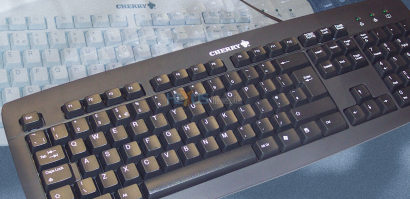CTS - 2006 :: Cherry looking to get back some cream
|
by Bob Crabtree
on 15 May 2006, 10:51
Quick Link: HEXUS.net/qafpn
Add to My Vault:
|
|
Cherry was once the number-one name in consumer keyboards but now takes a backseat to Microsoft and Logitech. HEXUS caught up with the company at the Computer Trade Show to see what products it's been introducing to try to grab back some market share.
If you were considering buying a keyboard four or five years ago, the brand name most likely to come to mind was Cherry. Today, though, it's more likely to be Microsoft or Logitech. Cherry still does good business, especially with corporates and consumers that appreciate the added reliability of switch technology over membrane. And it also has a wide range of special-function models, such as those with build-in barcode readers. But, in the consumer field, it's no longer top-dog or anything like it.
So, it was with considerable interest that we sat down to talk on distributor Enta's CTS stand with Cherry's keyboard sales manager Peter Smith to hear what the company was doing to try to regrow its market share in the consumer sector.
The first product Peter showed us was a keyboard that was being launched at CTS, a full-size, entry-level model that's set to retail for around £4 - less than half the price, a quick Google indicates, of any other Cherry model current sold in the UK. This, of course, uses a membrane, not switches, and has few frills - though it is available in black or white, offered in USB and PS/2 variants and claimed by Cherry to be of durable design.
Nobody makes a fortune producing keyboards that go out for four quid but that's not the point. It's intended to hit a price-point that will appeal not just to consumers but also to the retail trade and to system builders. If high-volume sales result, as Cherry hopes, that should help rebuild brand-awareness and, from there, enable it to increase sales of keyboards with better margins.
Among those, the sexiest is probably the wireless version of the CyMotion PRO. This is a slim and lightweight and comes packaged with a wireless mouse. It's said to be very rugged (it uses switch technology) and is also claimed to have a pretty decent range - up to 30ft - something we inadvertently tested.
Unknown to us, the keyboard we were looking at had been pulled off an active display some distance away on the stand and our random tap-tapping appeared on screen over there, ruining the demo being put on by some pro gamers who'd been carrying on using the mouse alone! Long range can be an asset in a number of situations but a problem in others and that's why the company provides a utility to cut it back if needed.
The keyboard is tiny - just 360mm wide, 155mm front to back and 30mm deep - and is was designed for use where looks are very important and desktop space is at a premium. Rechargeable batteries are included for mouse and keyboard - and there's a power input on each for the supplied charger - but disposable can be used, too.
Its small size means Cherry had to leave off the number pad. It also chose to fit only 10 function keys and move them away from their usual position. Instead of being up top, they're split into two stacks - one at each end of the keyboard - and that's going to take some getting used to.
However, the function keys and five others can each carry out two tasks - they're programmable using Cherry-supplied software and are paired with a dedicated key that's equivalent to the Fn function-shift key found on most laptops. And that's why Cherry got in some gamers to do the dem and show the versatility of the programming options. On the downside, the CyMotion PRO Wireless is pitched at a price - £60 (inc VAT) or more - that's higher than competing big-name keyboard-and-mouse wireless packages, though that's something that Peter says the company is looking to address by tighter control of costs during manufacture.
The other model we checked out was the G80/81-1800, described by Cherry as "compact and long-lasting" and said to have an MTBF (mean time between failures) of 80K hours. It's around 400mm wide and reckoned to be ideal for situations where a keyboard will be subjected to "brutal treatment". Naturally, Peter said that includes gaming.
But HEXUS.gaming writer Steven Williamson was on hand to point out that the sort of keyboards that serious gamers typically choose have a whole lot of dedicated functionality and now even include models that are designed specifically for use with one particular big-selling game or another. Peter was quick to respond, reminding Steven that Cherry was the maker of the Raptor K1 gamers keyboard - this was covered in our CeBIT 2005 report. He also said that the company was strongly considering producing something of the kind under its own brand - though Steven reckoned it ought to be more radical, perhaps including game-specific keyboards.
Thoughts on a possible Cherry comeback? Share them with us in the HEXUS.community.
HEXUS.links
Cherry Europe - Keyboards home page
Raptor K1 games keyboard - HEXUS CeBIT 2005 report
Raptor K1 games keyboard - SCAN Computer buying link
CTS 2006 - All the HEXUS coverage
HEXUS.gaming - Home page

















